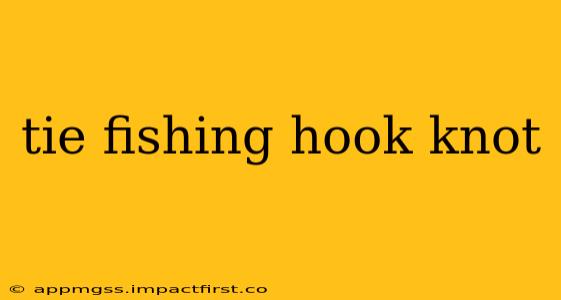Choosing the right fishing hook knot is crucial for a successful fishing trip. A poorly tied knot can mean the difference between landing the catch of a lifetime and losing your lure. This comprehensive guide will explore several popular and reliable knots, helping you select the best one for your needs and fishing style. We’ll delve into how to tie each knot effectively, addressing common questions and concerns along the way.
What are the most common fishing hook knots?
Several knots are exceptionally reliable for tying fishing hooks, each with its strengths and weaknesses. Some of the most popular include the Palomar Knot, the Improved Clinch Knot, and the Uni Knot. The best knot for you will depend on the line type (monofilament, fluorocarbon, braided) and the type of hook you're using.
How to tie a Palomar Knot?
The Palomar Knot is known for its strength and simplicity, making it a favorite among anglers. Here's how to tie it:
- Double the line: Double your fishing line, leaving a loop at the end.
- Pass through the eye: Pass the doubled line through the eye of the hook.
- Form a loop: Make a loop with the doubled line.
- Pass through the loop: Pass the loop over the hook shank and back through the loop itself.
- Tighten: Pull the line tight, snugging the knot up against the eye of the hook. Trim the excess tag end.
How to tie an Improved Clinch Knot?
The Improved Clinch Knot is another popular and highly effective choice. It's relatively easy to learn and very reliable.
- Pass through the eye: Pass the line through the eye of the hook.
- Wrap the line: Wrap the line around the hook shank five to seven times, depending on your line thickness and preference.
- Tuck and tighten: Tuck the end of the line through the initial loop next to the hook eye.
- Moisten and tighten: Moisten the knot and gently pull it tight. Carefully trim any excess tag end.
How to tie a Uni Knot?
The Uni Knot is particularly useful for tying lures and swivels, and is strong and reliable for fishing hooks as well.
- Pass through the eye: Pass the line through the eye of the hook.
- Form a loop: Make a loop in the line, keeping it in place with your thumb and forefinger.
- Wrap the line: Wrap the end of the line around the loop four to six times.
- Pass through the loop: Carefully pass the end of the line through the loop you initially formed.
- Moisten and tighten: Moisten the knot and gently pull it tight. Trim the excess line.
Which knot is strongest for fishing hooks?
While the strength of a knot depends on several factors including line type and the tying technique, the Palomar and Uni knots are often cited as being among the strongest for fishing hooks. However, all three knots discussed above are excellent choices and are highly reliable when tied correctly.
What is the easiest fishing hook knot to tie?
The Improved Clinch Knot is generally considered the easiest to learn and tie, especially for beginners. Its straightforward steps make it a great starting point for learning various fishing knots.
How tight should I make my fishing hook knot?
The key is to avoid over-tightening, which can weaken the knot. Gently tighten the knot until it’s secure, ensuring you maintain the shape and integrity of the knot itself. Too much pressure can cause the line to break near the knot.
Why are my fishing knots failing?
Failing fishing knots are often due to improper tying technique or using a knot that isn't suited to your line type. Ensure you are following the instructions carefully and consider using a knot specifically designed for the line you’re using (braided line needs different knots than monofilament). Also, using worn or damaged lines can significantly affect knot strength. Inspect your lines before each fishing trip.
By understanding these knots and practicing their execution, you can significantly improve your fishing success. Remember, practice makes perfect. Experiment with different knots to find the one that best suits your style and preferences. Tight lines!
